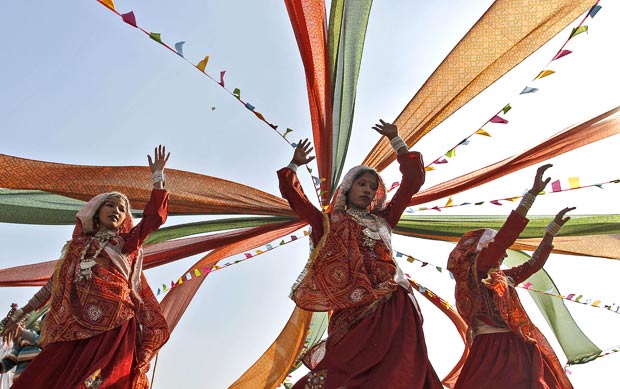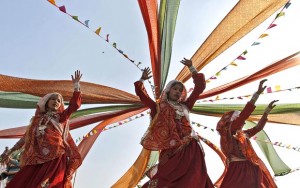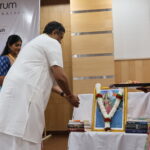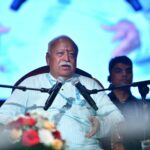
In Texas, young Hindus want to Americanize ancient faith
Houston, Texas (CNN) – In many ways, 29-year-old Rishi Bhutada is a traditional Hindu, not so different from his Indian-born parents.
An officer at his dad’s pipefitting company, Texas-born Bhutada had an arranged marriage in India three years ago and then brought his wife back to his hometown, where they recently welcomed a son.
Bhutada is a strict vegetarian and avoids alcohol, as do many observant Hindus.
Complete coverage: Defining America
And the dashboard of his Toyota Prius is adorned with a small metal statue of Ganesh, an elephant-headed Hindu god known as the remover of obstacles. Bhutada prays to it each morning before leaving his driveway.
And yet Bhutada is a different kind of Hindu than his mom and dad.
His parents were part of a major wave of Indians who arrived in the U.S. in the 1960s and ’70s and focused their religious lives on building a community of believers and temples around Houston, which was then a Hindu wilderness.
Bhutada, by contrast, wants his religion to step out from that now-well-established Hindu hive to engage the broader culture.
Surprising origins of “Don’t Mess with Texas”
Driving to lunch recently at a strip mall Indian buffet, he spoke of trying to forge a distinctly American Hindu identity that’s more tightly woven into the national fabric.
“The immigrant generation is focused on India, on the home country,” he said, noting that the TV in his parents’ house is often turned to a Hindi-language channel beamed in from the subcontinent. “I’m focused on the United States, which is my home country.”
That helps explain why a national group he’s involved with, the Hindu American Foundation, recently launched a Take Back Yoga campaign, aimed at raising awareness about the practice’s Hindu roots and values among non-Hindus.
And it’s why Bhutada testified at the Capitol in Austin last year against a statewide school curriculum that calls Hinduism a polytheistic religion, a characterization many Hindus reject.
And it’s why one area temple has begun placing copies of the Bhagavad Gita, a Hindu scripture, in thousands of Texas hotel rooms, right next to the Gideon Bible.
The developments speak to a new, publicly assertive stance that’s shared by many first-generation American Hindus across Houston, home to one of the country’s largest and fastest growing Indian enclaves, and by many young Hindus across the nation.
“Our parents had to build everything from scratch to make a united Hindu community in this country,” said Tejas N. Dave, 17, a high school junior who volunteers with a project bringing yoga to unprivileged Americans.
“Now we’re trying to reintegrate it back into society,” he said, “to make people realize that Hinduism is a religion and a way of life and a philosophy that’s not too different from what a lot of others believe. We’re all trying to make a better society.”
Some young Hindus are envious of the attention that American Muslims and Mormons have received in recent years – even if not all of the attention has been positive – and are trying to raise Hinduism’s national profile.
The impulse is not about winning converts. Hinduism, the world’s third-largest religion, doesn’t proselytize.
Rather, many young Hindus say, it’s about making their faith less exotic to others while making it more meaningful to their own modern American lives.
When their parents arrived from India a few decades ago, it was hard enough just being Hindu.
The Immigration and Naturalization Act of 1965, which overhauled the U.S. immigration system by eliminating biases toward European immigrants, among other things, opened American doors to millions of Asian immigrants, including Indians.
Those first arrivals struggled to recreate ethnic and religious networks from back home. When Bhutada’s father, Ramesh Bhutada, arrived in the U.S. in 1968, Houston played host to a single Hindu temple, which had opened earlier that year.
It was a stark change from India, where Hindus can stop into seemingly ubiquitous temples every day for brief visits, helping explain why so many Indians say “Hinduism is a way of life.”
There were more prosaic struggles, too. Many Hindus believe that vegetarianism denotes religious purity and a commitment to nonviolence, but they struggled to maintain that tradition in what was then a very meat-centric American diet.
“There was not even anything like a vegetable burger in those days,” Ramesh Bhutada said.
In those early years, new Hindu arrivals turned their homes into makeshift temples, holding religious education classes for their American-born children.
“There would be kids’ activities in one bedroom and adults in another,” said Dhruval Amin, 28, a Houston-based project manager at an international consulting firm, recalling childhood visits to such homes.
Today, Amin worships at the BAPS Shri Swaminarayan Mandir, a sprawling, snow-white temple carved from Italian marble and Turkish limestone that sits on 22 manicured acres in Stafford, just south of Houston.
Opened in 2004, the temple is a proud symbol of the local Hindu community’s growth and prosperity, though it’s a story that’s hardly confined to Houston.
The U.S. Census does not track the number of Hindu Americans; the Census doesn’t ask about religion, period. But data from the 2010 Census show that Texas’ Asian Indian population nearly doubled in size in the past decade, to around 250,000.
Now, for the first time, Indians represent the largest Asian community in the state. Many were drawn by lucrative jobs in Texas’s booming oil, technology and medical sectors.
“A lot of the doctors in small metro markets across Texas are first- or second-generation Indians,” said Ray Perryman, who heads an economic research firm in Waco, Texas. “And the top two or three students in every high school tend to be from some part of Asia.”
Similar trends have emerged in other parts of the country. Nationally, Indian growth has surged by 60% in the past 10 years, according to the Census, with 2.8 million Asian Indians living in the U.S. today.
Indians now represent the country’s second-largest Asian group, after the Chinese.
They’re also among the nation’s most successful ethnic groups, with 71% of Asian Indians earning bachelor’s degrees or higher, compared with 28% of all Americans, according to data from the U.S. Census’s 2009 American Community Survey.
The survey reported that Asian Indians have median household incomes of more than $90,000, compared with $50,000 for all Americans.
Not everyone from that community is Hindu. India’s Christian, Muslim, Sikh and Jain minorities are also represented in the United States.
At a recent yoga class at Houston’s India House, a community center, the instructor was Hindu, and most participants were Indian, but half were Catholic, Methodist or another kind of Christian.
When the instructor, Sarika Phalak, leads open and closing prayers that reference God, she invites participants to speak the name of their own deity. Many say “Jesus.”
Still, Hindu growth around Houston has exploded in recent years, with 19 temples now scattered across the sprawling metropolitan area, most built just in the past decade.
Temple-based Hindu youth camps long ago replaced home-based classes. And several national Hindu organizations now call Houston home.
The city’s Hindu onslaught put Charu Krishna Thammavaram, 28, in closer touch with her religion when she relocated from Lafayette, Louisiana, three years ago.
“I feel like a born-again Hindu now,” said Thammavaram, who works for an international Hindu humanitarian group called Ekal Vidyalay, which is headquartered in Houston.
In Louisiana, the lone “nearby” temple was an hour’s drive from Thammavaram’s home. Here, she had her choice of temples and settled on a Hare Krishna temple after shopping around, just as many Americans of other faiths do.
For many young Hindus, tweaking their religious heritage to make it more relevant has become an important project.
“My parents were just immersed in Hinduism, starting every day with prayer and accepting it without question,” said Kavita Pallod, a native Houstonian and first-generation American who recently graduated college. “But I don’t start my days with prayer. And Hinduism is something I’ve questioned and debated with friends.”
Yet Pallod, 23, has spent a good deal of time thinking about how to apply her faith to her life. “I believe that karma is the principal that guides the universe,” she said, referring to the Hindu concept of cosmic justice. “It’s one of the reasons I joined Teach for America.”
Pallod, who’s training for the teaching program this summer, was speaking at Star Pipe Products, the pipefitting distributor where Rishi Bhutada works and that his father, Ramesh, founded in 1982.
Situated at the end of a bland industrial drive on the city’s west end, the company doubles as a meeting place for local Hindus.
Among its warren of warehouse and offices spaces is a community center where a mural of Swami Vivekananda, a famous 19th-century spiritual leader who introduced the faith to the United States, fills the back wall.
But like the younger Bhutada, Pallod is intent on taking her religion outside officially Hindu spaces. As the president of the Hindus Student Association at the University of Texas at Austin until her graduation in May, she focused on introducing Hinduism to non-Hindu students.
Last spring, her group went all out to get non-Hindus to participate in Holi, a Hindu festival that involves throwing colored powder and water – often at other people – in a playful, rainbow-like spectacle.
“We wanted them to actually experience it themselves as opposed to just sitting there passively,” Pallod said of the event. “We wanted to teach that the colors are all about eliminating differences by making everyone look the same.”
The festival drew about 2,000 people, with many enthusiastically throwing colored powder at one another in the shadow the state Capitol. It was the kind of scene that Indian immigrant parents could have never imagined.
Source: http://religion.blogs.cnn.com/2011/07/10/in-texas-young-hindus-want-to-americanize-ancient-faith/






